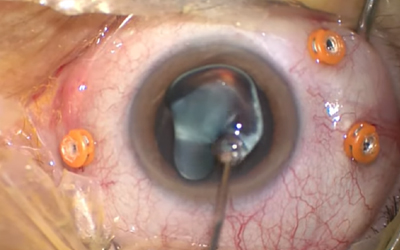Vitrectomy
Vitrectomy is a type of eye surgery used to treat the problems of retina and vitreous of the eye. Some or all of the vitreous will be removed by the ophthalmologist from the middle of your eye during vitrectomy.

Some facts about Vitrectomy:
- Blood or other substance keeping light from focusing properly on the retina as well as the scar tissue that is wrinkling or tearing the retina and causing poor vision will be removed during vitrectomy.
- Vitrectomy help repair a retina that is pulled away or has detached from the eye wall.
- A foreign object stuck inside the eye from an injury can also be removed during vitrectomy.
- A vitrectomy is recommended if you have diabetic retinopathy, with bleeding or scar tissue affecting the retina or vitreous gel; severe eye injury; certain problems during cataract surgery; an infection in the eye called endophthalmitis; macular pucker (wrinkles or creases in the macula) or some forms of retinal detachment (when the retina lifts away from the back of the eye).
- There is formation of fluid in the vitreous to cloud, filled with blood or debris, harden, or scar which can keep light from reaching your retina properly and cause vision trouble. The problem can be resolved by removing and replacing the fluid.
- Vitrectomy can be done to make it easier to get to your retina and repair it when the retina pulls away from the tissue around it.
- Vitrectomy surgeries are often done as part of other eye surgeries.
- Vitreous humor is a gel like substance that is made of at least 98 percent water.
- The round shape of the eye is due to the vitreous cavity and it makes up at least two-thirds of the volume of the eye.
- Most people can go home after vitrectomy surgeries, following a short monitoring period as it is an outpatient surgery.

Preparation for Vitrectomy:
- You may need to stop taking certain medications beforehand.
- You will be asked to avoid food and drinks for at least 8 hours before the surgery.
- A routine eye exam and physical will be done by your doctor for the eye that will be operated on..
- You will receive a local or a general anesthesia to numb the eye.
- An antiseptic solution will be used to clean the eyes and draped with a sterile covering.
- An eyelid speculum will be used to keep the eye open, and a protective covering is placed over the eye that is not being operated on.
- Surgery can take one to several hours depending on the condition you are treating.
Procedure for Vitrectomy:
- You may have to stay awake and use numbing drops or shots in your eye, or you might get general anesthesia that helps you go to sleep during surgery.
- A small cut will be made by the ophthalmologist or special blades are used to insert the instruments into the white of the eye (sclera) during surgery.
- Usually 0.5 millimeters or about the width of an eyelash of cut will be made in the outer membrane of the eye.
- The eye will be accessed through the pars plana, a structure in the sclera or white part of the eye.
- Forceps will be used by the surgeon to open the cut.
- A microscope as well as a fiber-optic light will be used by the ophthalmologist to see inside your eye.
- A vitrector or vitrectomy probe will be used to cut the vitreous gel, and a suction tool will be used to remove broken down fluid.
- Tiny tools are used to either remove all cloudy vitreous, scar tissue from the retina, any cataracts, any object that should not be in the eye or use a laser to repair a torn retina or other procedure.
- An air or gas bubble ill be placed in your eye to help the retina remain in its proper position.
- A silicone oil bubble in your eye will be placed which will be removed later during second surgery.
- Your doctor will make any other repairs your eye needs once the fluid is removed. Then your eyes will be filled with saline.
- Antibiotic ointment on your eye and cover it with a patch.
Recovery from Vitrectomy:
- Antibiotic drops will be given to help prevent an infection in your eye.
- Medicine will be prescribed to help the eye heal appropriately and to relieve eye discomfort.
- Pain is very rare after vitrectomy. However, a scratchy, sandy, or gritty sensation inside your eye is common which will disappear with the medicines and time.
- You can take over-the-counter pain relievers if your eye feels sore.
- Your eyes will be checked after the surgery as soon as the day after the procedure, and you will be closely followed the next couple weeks.
- A patch will be given on your eye for a few days to protect it.
- You may need to keep your head in a facedown position for a specific period of time if a gas bubble was placed in your eye.
- You are not advisable to fly in an airplane, go to the mountains or scuba dive until the gas bubble is gone as a rapid altitude change can affect the size of the bubble.
- Complications from Vitrectomy is rare and depend on the condition of your eye and the work that needs to be done to repair it.
- There is a chance of getting Cataracts, Raised pressure inside the eye, More bleeding in your vitreous, Retinal detachment, Infection and Problems moving your eyes after a vitrectomy.
- Infection, bleeding, torn or detached retina, poor vision glaucoma, when pressure builds up within your eye are some of the risk of vitrectomy surgery.
